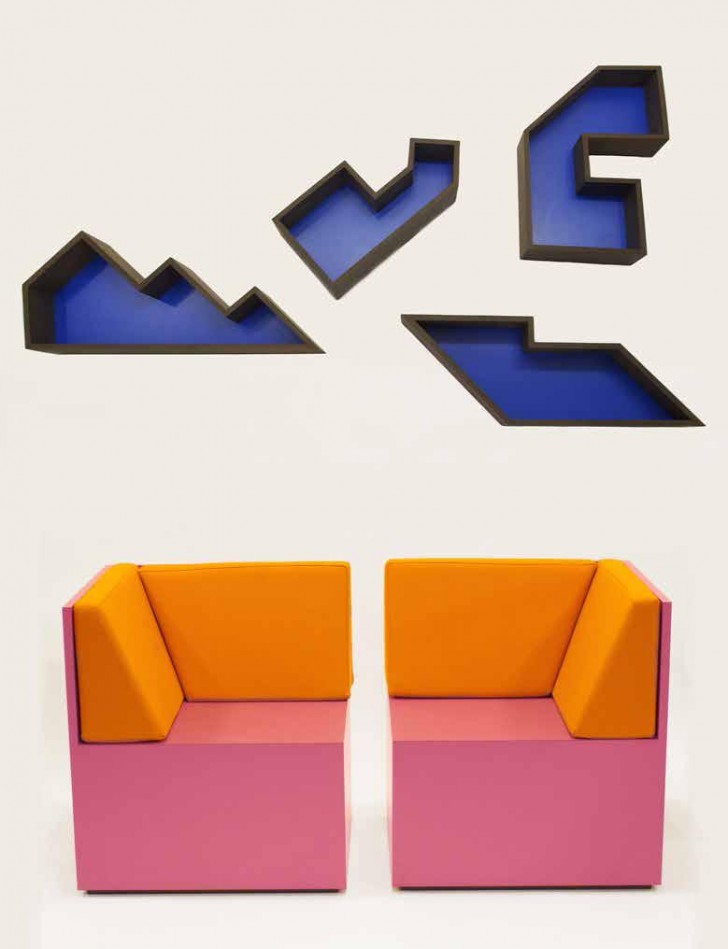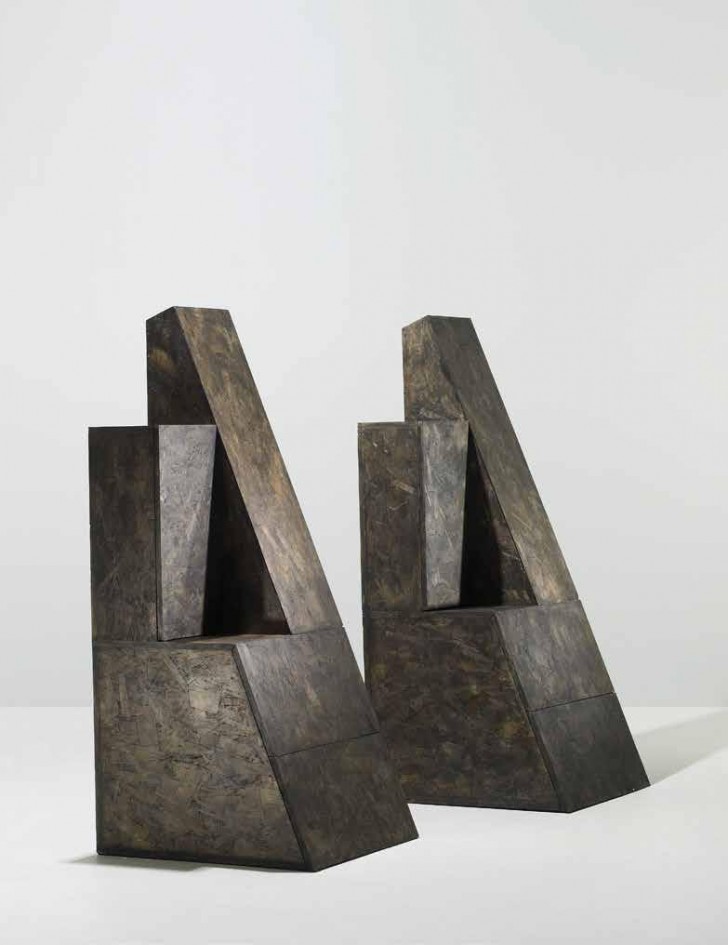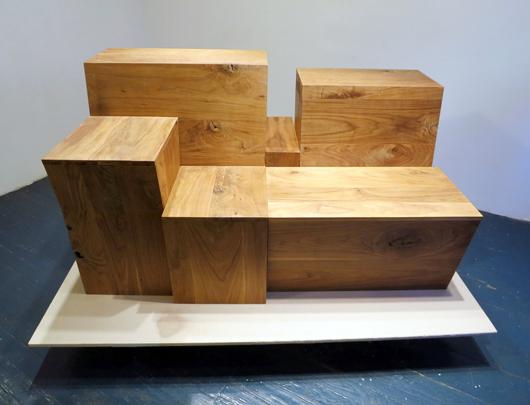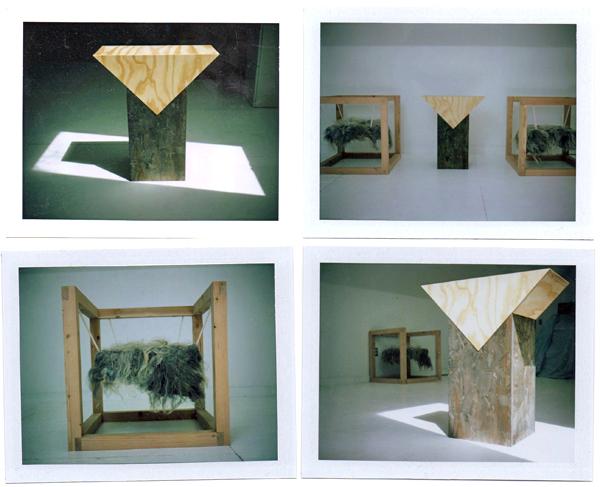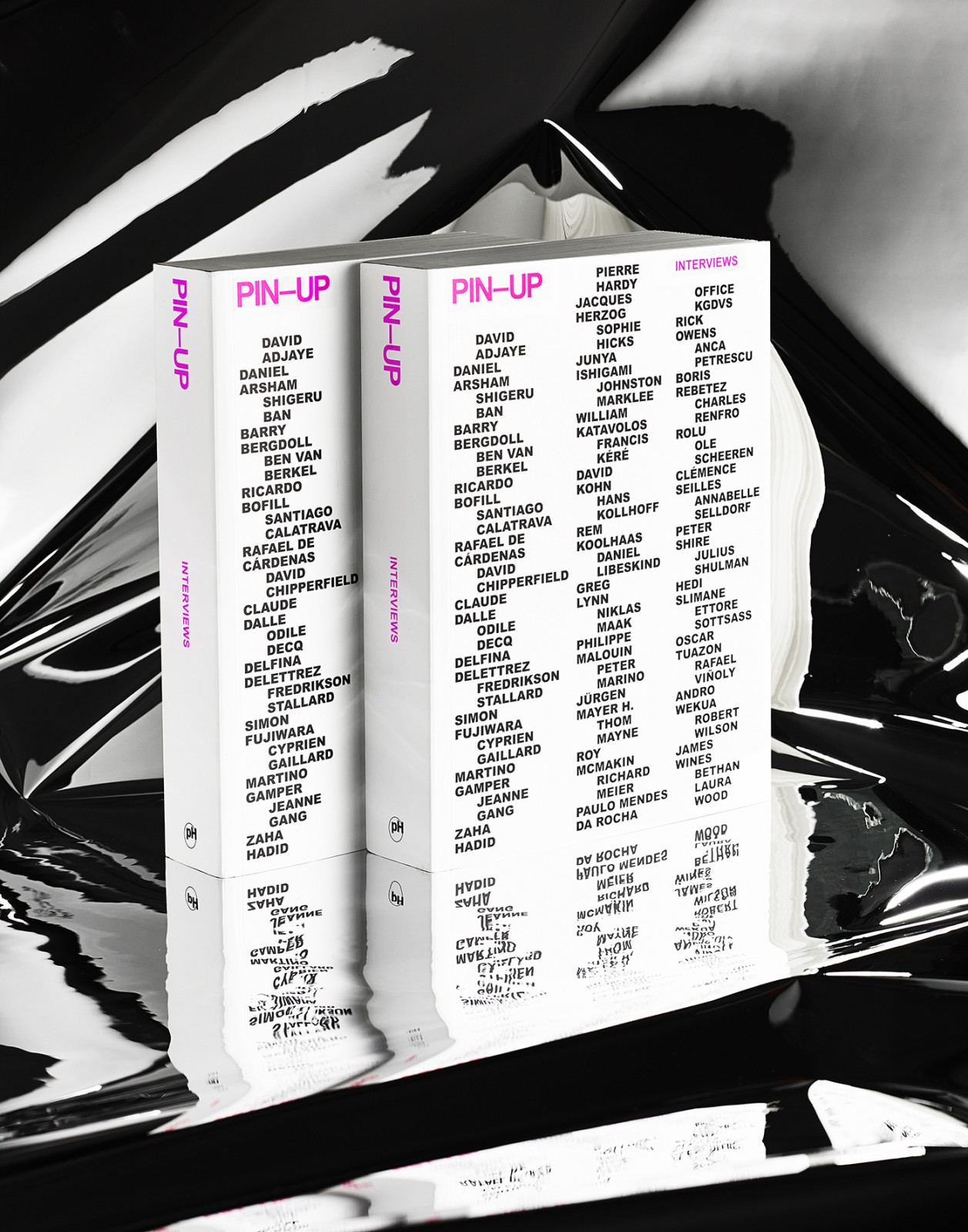
10.04.13
Excerpt: Book
PIN-UP Interviews
It’s quite nice to write, as we do here at Sight Unseen, for ourselves, but it’s equally — if not sometimes more — fun to write for PIN-UP. When you’re a writer assigned to conduct a Q+A in the “magazine for architectural entertainment,” as I was earlier this year, you take one look at past examples and breathe a huge sigh of relief. For PIN-UP has always encouraged both writer and subject to be absolutely themselves, and its founder and editor-in-chief Felix Burrichter has always allowed transcripts into the magazine complete with exclamation points, interjected giggles, and tangents about things like Beyonce’s hair, Philippe Malouin’s “lustrous beard” or what kind of stationery is Shigeru Ban’s favorite — in other words, all of the fun, non-jargony things that often make an interview entertaining to conduct but that usually get edited out.
This week, PIN-UP Interviews — a book filled with seven years’ worth of those conversations — was published by PowerHouse Books. In the foreword, Burrichter explains his method: “Every issue of PIN-UP is driven by the desire to introduce the culture of architecture and design to new audiences. Fueled by a healthy curiosity for the fresh and the new, but also the forgotten and the overlooked, PIN-UP never shies away from the seemingly superficial — but always with the belief that surfaces are deceptively shallow, hiding surprising depths, and that a less serious approach can often be the more revealing.” The book offers straight talk from 57 design and architecture celebs from Roy McMakin to Rick Owens to ROLU’s Matt Olson, who met up with me for an afternoon at the Noguchi Museum earlier this year for the interview we’re excerpting below. For the full text, and much much more, snag a copy here. (Photo credit above: Adrien Gaut)
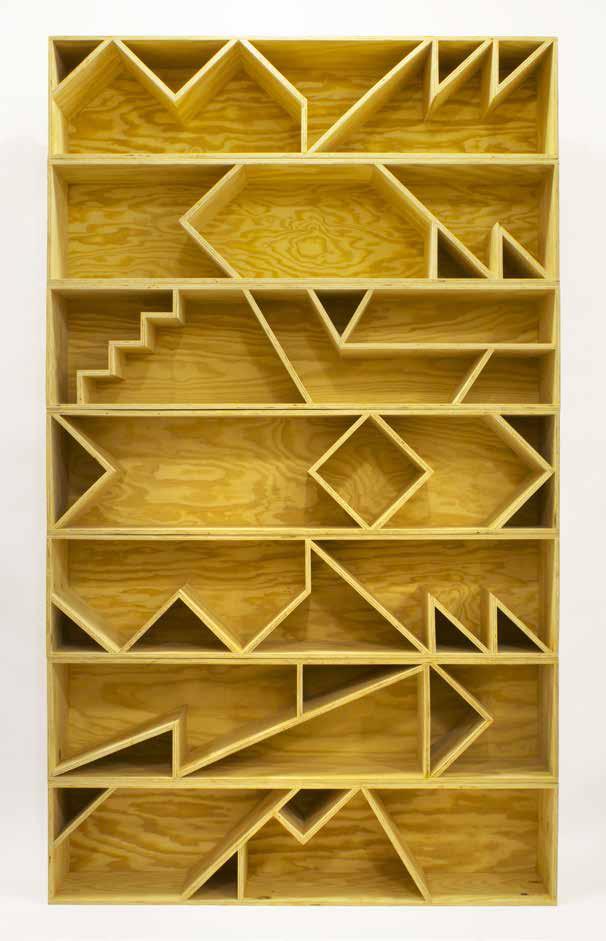
RO/LU
By Jill Singer
What is RO/LU? In its most literal sense, RO/LU is co-founders Matt Olson and Mike Brady, former punk-rock musicians who met in Minneapolis in the early 1990s and began working together as landscape architects over a decade ago (the name RO/LU pays tribute to their mothers’ maiden names, Rosenlof and Lucas). In 2010, RO/LU debuted their first furniture collection — a series of 22 pieces in plywood and oriented-strand board, inspired by sculptors and furniture greats like Scott Burton and Enzo Mari — that quickly shot them to the forefront of the American furniture-design scene. But to hear them tell it, RO/LU is something much more amorphous than that. It is a concept and an ethos, both the sum of its influences and the result of a long list of collaborators, among whom are Patrick Parrish, the New York gallerist who gave them their first show and ultimately became their dealer, sound artist Alexis Georgopoulos, with whom they mounted an installation at New York’s Museum of Arts and Design, and Sammie Warren, a one-time third partner who left RO/LU just a few days before I met up with Olson at the Noguchi Museum in Long Island City, Queens. Olson was on his way back to Minneapolis after a month-long residency on Captiva Island, the former home and studio of Robert Rauschenberg and the site of the inaugural Rauschenberg Residency. Olson is RO/LU’s figurehead and de facto mouthpiece — he’s been running the firm’s much-loved blog since 2007 — and, after spending a month on a private island with only a dozen or so residents, was ready to talk.
JS: Let’s start with the Captiva residency. Was there a specific project that you worked on there?
MO: We actually built these crazy aluminum chairs, new versions of our Primarily/Primary Chairs — the ones with the fur. Instead of the wood armature we used metal and acrylic. It’s transparent, but really strong, too.
JS: Did you go down there knowing what you were going to work on?
MO: No. Rauschenberg’s dream was to create a small version of Black Mountain College, kind of a collaborative free-for-all. So there were choreographers, photographers — everybody did something different. When they asked me, I was concerned because I’m not the maker in RO/LU; Mike and Sammie make things, and I think things. So do they, but making things is not my role. But the Rauschenberg folks said, “If you want to just ride your bike and talk to people, that’s fine too.” It’s really open. I also shot a music video when I was down there for Alexis Georgopoulos. I collaborated with a choreographer named Allie Hankins and we put a camera on her forehead to see the dance through her eyes. There was this beautiful French artist, Laura Brunellière, who helped and it was great because the choreographer would stop and then it was Laura’s job to try and recreate the moves. She’s not a dancer. So she would laugh and start trying to dance and you would see that through Allie’s eyes. It was about the space in between them and learning in motion.
JS: Being relatively isolated on Captiva, did you have any epiphanies or new thoughts about the way you guys practice RO/LU?
MO: I think it was almost more reinforcing. The way we work borders on recklessly plowing forward and trusting, rather than starting with a premise. A lot of friends who are designers are about narrowing; I’m more interested in expanding. While I was there, I was reading about Black Mountain College and thinking about the way Bob worked, and it was like, “Oh yeah, this does work out.” Because sometimes I get scared that we should be more about precision and clarity, but now I’m pretty certain that will just come later.
JS: Is it possible that you feel that way because you’re thinking rather than making, and you’re trying to resolve all of these disparate ideas in your head?
MO: I don’t think there’s a hierarchy to building versus thinking. I don’t know that objects are really that different from ideas. I will remember this Noguchi sculpture and until I see it again in real life, it will just be an idea or a memory.
JS: Memory seems to play a big part in RO/LU’s work. You often create a piece in the spirit of another artist, but it’s never a 1:1 reproduction, it’s more like a half-remembered interpretation. I recently read a quote by you where you explained it like this: “We seek to recreate an image in a way that is vaguely related to appropriation, but since we generally re-contextualize the objects we reproduce by making them in simple hardware-store materials, we think it has more in common with sampling in music.” What do you mean by that?
MO: My grandfather was a modern architect and, when I was little boy, he had this coffee-table book about modern architecture. There were these pictures of the Mies van der Rohe Farnsworth House, four images on two pages and they were iconic. I’m sure you’ve seen them. They’re still burned into my mind and I feel like, if I were able to draw, I could make them perfectly. When I started blogging, I started noticing that the way pictures surround us now is different and I was thinking about the way samples work in music. A lot of times you know the source, but it is becoming something else. That first line of furniture we did, which we called “Field Recordings Made of Wood,” was trying to allude to that.
JS: How so?
MO: If you’re standing in a public square, recording sound, things are unfolding at a fairly quick rate. That work happened like that. It was based on some Scott Burton stuff, some Schindler, some Rietveld, but it came together as a group. We came to New York and built 22 pieces in about two weeks. It was this fast-paced explosion that seemed more like a field recording, a set of sounds, than a strategic group of pieces. Most of the time we think about totality and what pieces mean to each other. But the only thing those pieces have in common is their material.
JS: I think when you look at them together they actually do seem very similar. They all share a certain visual blockiness, and many of them have a similar geometric base.
MO: Yeah, but I think that’s something outside of us. I believe there’s some kind of order that we’re a part of and it reveals itself. As a studio we create situations where work is produced but part of the outcome seems to be happening based on decisions that we never made. That’s true of all the work we do. We’re usually surprised by the outcome. There are definitely connections, but it’s not necessarily by plan.
JS: Going back to the overabundance of Internet imagery, I wanted to ask you if you were on Pinterest?
MO: I’m not, no.
JS: That’s surprising.
MO: I know, it is. I had to stop Tumblr, too, because it was too easy.
JS: You like the thrill of the chase?
MO: Yeah, and I like to learn. If it’s too easy to just hit a button and it’s on your wall then it’s harder for me to care.
JS: I find Tumblr frustrating because so much isn’t attributed. You find something, and you’re like, “Oh my god! What is this amazing thing?”, and you’ll never know.
MO: See, I like that. I’ve had a long debate with R. Gerald Nelson who wrote a book about Tumblr. He can’t stand it that these images are out there and it doesn’t say who it is. But I feel that it’s leading to a breakdown of the academic, institutional hierarchy around art history. That excites me. We’re in a moment where, if you wanted to, you could write your own history. An art historian would say this Noguchi sculpture doesn’t have anything to do with Donald Judd. But It does to me — it’s exciting to me that you can put Judd and Noguchi together and it makes a perfect image, visually.
JS: Do you have any formal training in design or art?
MO: No. I went to school for one year for psychology. My first semester I got a 0.0 grade-point average — I flunked all my classes.
JS: What were you doing?
MO: Just drugs. The second year, I was asked to move along and I went to treatment. Then through my 20s I was in a band and toured.
JS: But you were around design growing up?
MO: My great-grandfather was a Herman Miller dealer in Sioux Falls, South Dakota, and a few other small towns around the Midwest. And as I already said, my grandfather was an architect. My dad’s dad was a violinist. To me, it all kind of makes sense.
JS: You mean it’s in your blood?
MO: It is, in a way. But I do feel like I study. There’s an architect named David Salmela who is based in Duluth, Minnesota, but works internationally. He’s great, and is self-educated. Richard Nonas — he didn’t study art. I’m always attracted to people like that. I know so many people who have, like, a Master of Fine Arts from Yale, so I’m a little self-conscious about it. But you know, when I did music for a living, I didn’t know how to read the chords. People would urge me to study music, but then they’d say something like, “When you’re writing and you need to be creative, you just forget everything you’ve been taught.” And that never made sense to me! The upside is that, again, I don’t have much sense of an institutional framework. To me, it makes perfect sense that the magazines of Archizoom connect to the zines of punk rock’s past, and that punk rock’s ethos connects to Enzo Mari’s Autoprogettazione, and that Sottsass connects to Angelo Plessas, and Kaprow makes me think of Abraham Cruzvillegas who connects back to punk rock. It doesn’t seem like a linear set of events — it all seems like water, mixing together like the ocean. And the non-Internet exposure I’ve had to art history presents things in an impossibly boring and linear matter-of-fact fashion.
JS: Even if you have an MFA from Yale, though, you have to keep it up. And you seem like you immerse yourself in this stuff everyday.
MO: I do. This is my life. I have a wife and a dog and my interests and that’s about it.
JS: Your shows often have elliptical titles like “When Does Something Stop Becoming Something Else” and “Everything is Always Changing All the Time,” which was a quotation from John Cage. Do you ever worry that, because you reference obscure texts, it will come across as overly intellectual or pretentious?
MO: I can’t control what anybody else thinks. But I am sometimes bummed out because I feel like I’m the most gregarious and jovial person and totally not intellectual at all. Sometimes people say, “Man, I don’t know what the hell you’re talking about,” and I can tell that they’re inferring that it’s somehow convoluted in an intellectual way. But it doesn’t feel that way to me. I think you just have to do what you want to do in life. You can’t worry about what other people think.
JS: Actually I’ve had one of those “I don’t know what the hell you’re talking about” moments! I didn’t know who Scott Burton was before I knew your work. I was looking him up and I saw he has this seat that’s kind of similar to the stools from Max Lamb’s China Granite series. Have ever talked about collaborating with Max?
MO: We have talked about it. You know, somebody told me that Max Lamb didn’t know Scott Burton’s work, and I believe it because we had a crazy thing happen: we did a project at Sit and Read Gallery in Brooklyn last year where we poured a concrete Burton, and a week before that, Oscar Tuazon, one of my favorite working artists right now, poured a concrete Scott Burton in Rome! When I saw it, I got really anxious, but we really didn’t know of each other’s projects.
JS: Did you contact Tuazon after the fact?
MO: I did. And it was way more interesting than it was weird. I guess I believe there is some sort of order outside of us that makes that kind of thing probable.
JS: I think part of it is the Internet, where all of those images are out there so much more than they would’ve been before.
MO: I think we are all becoming each other, and the Internet is speeding it up. We’re all seeing the same things and sharing the same ideas. It only makes sense that people would come to the same conclusions. How many blogs look just like Haw-Lin? But nobody’s like, “This is bullshit!” One of the things I’m interested in is, if you say something to me that’s profound and it enters me and I carry it around, when does that become me? Or does it always stay you? And where did it come from before you? I think there’s something really productive in seeing the ways in which we’re connected. I also think a lot of artists or designers feel nervous about saying, “Yeah, this is based on a Noguchi,” they hope nobody knows. That doesn’t seem productive to me. We’ve always been excited to share what we’re doing and where it’s coming from. Almost every piece we do says “after” at least one person — after Carol Bove, after Scott Burton, after Sol LeWitt. We want to point to the past and its presence in our now.
